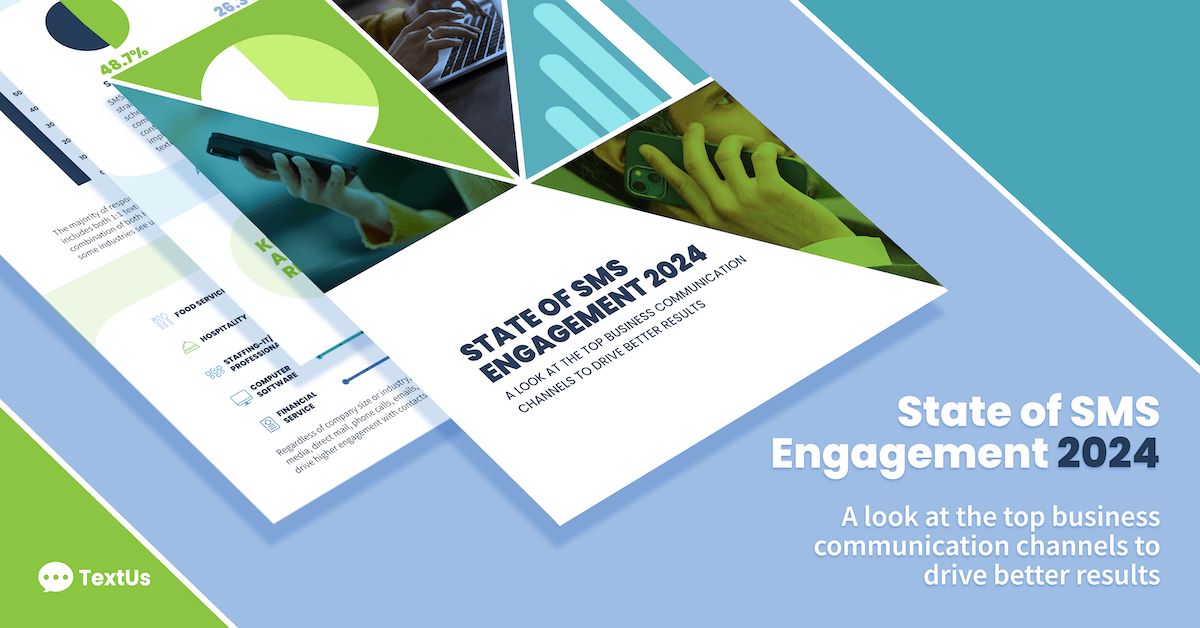Shoot Me a Text: How Market Leaders are Winning the War on Voicemails

Not all communication channels are created equal. In an environment where email response rates are declining and playing phone tag with voicemails is time prohibitive, is it appropriate in a business setting to text in order to get responses faster? Absolutely.
We think every business should be able to say, “shoot me a text.”
We looked into the TextUs platform to find out how some industries are winning the war on voicemails by sending texts instead. While there are some differences by industry, the biggest takeaway is knowing your audience and whether you are communicating with customers or employees. Internal and external communications may impact your texting strategy.
Want to watch the webinar where we go into those findings in more detail? Here’s our recording.
Let’s Have a Real Conversation
Texting has a 38.3% response rate. One reason for this is that people are looking for real-time engagement and a real person. If you’ve struggled with getting people to respond to you on your communications tool of choice, the good news is that there are things you control and help users engage with you.
You can control the platform on which you communicate with people, the type of content, the length of content, and when you communicate.
Finding the right balance between conversational text messages (1:1) and automation (mass, scheduled texts) matters in the type of content and how you deliver it.
“Even though automation is easier, it actually makes it harder at the end of the day.”
-Martin Payne, TextUs CEO
Automation has its benefits and uses, but it may become harder to convert based on where users are in your funnel. Knowing your audience and where they fall in their journey will allow you to find the right mix of conversational texts and automation.
TextUs data shows that conversational texts can produce between two to five times greater response rates. We see a discrepancy between conversations to employees and customers. Here is a look at how to control your text communications whether you are working with employees or customers.
Employee Communication
TextUs customers using the platform to communicate with employees are in the staffing or healthcare industries.
Our data shows that they are using automation more than conversational text messaging and their response rates are a little lower than other industries. They are implementing conversational text messages less than half of the time.
Shorter messages are generally better received with employee communications, but one industry requires it: healthcare employees. Doctors and nurses always prefer shorter communications, but especially during a pandemic when regulations and landscape are changing so frequently. They want to receive the information as quickly and directly as possible.
As you might know, links within a text message can deter users from responding or taking action, often because people are hesitant to click on a link they don’t recognize. Since employees know you, they may be more willing to click on a link in the first message you send. Employees are also encouraged to see an emoji or photo in the first text message they receive from you.
Clinical messaging (doctors, nurses) will want a plain text only. No photos (unless it’s vital to the information they need) or links.
Customer Communication
The top three industries with the best response rates from our data are real estate, financial services, and education. These industries all implement conversational texts more than half of the time — with real estate near 80% compared to near 20% automation.
These industries are also texting customers. Whether it’s with potential buyers, borrowers, or students, conversational texting has been a major win for them and they see users responding to them.
Customers are more tolerant of longer text messages. If you send a message to a consumer with more than 100 characters, it will not likely affect your response rate drastically.
Since customers may not know your brand yet, the first message you send should only include text and not any links. The real estate industry benefits greatly from using images during a first send. This is where knowing your customers becomes important. Potential buyers rely on curb appeal and a picture of a house may increase their engagement.
Best Practices for Texting
Make sure you know your audience and where they are in their journey so you can find the right mix of conversational texts and automation. We recommend conversational make up more than 60% of your texts!
You also want to look for a texting platform that matches your workflow and needs. Our data usage shows that users respond within two hours of you sending a text. If you want to have a conversation (hint: you do!) make sure you have mobile, chrome extension or or web app connections that are easy to use so that you can reply within that two-hour window!
Even though the response rate is quick after the first send, you can increase engagement by 20% by sending an additional two follow-up texts.
Make sure you have training for users. If users don’t understand the platform or have a positive user experience, they will stick to phone or email since it’s more familiar even though those see lower response rates. Usability can increase response rates ten times.
Remember: there are things you can control in your communications. It starts with knowing your audience and finding the right platform and content to communicate.

Get a TextUs Demo
Learn how thousands of businesses use TextUs everyday to communicate in real-time.



